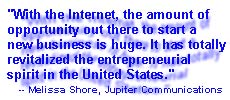|
Brave 'new economy'
|
 |
May 22, 2000: 6:12 a.m. ET
It's like nothing anyone has seen. How has it changed the rules of business?
By Staff Writer M. Corey Goldman
|
NEW YORK (CNNfn) - It has been dubbed the "new economy" for the simple reason that no one has seen anything like it -- an era in which growth and innovation has created jobs that never existed, boosted productivity to new heights and driven the economy forward for such an extended length of time.
According to the record books, not since the Industrial Revolution has the U.S. economy enjoyed such an extended and prosperous period of uninterrupted growth -- mostly due to rapid advances in technology that have completely altered the business landscape.
It is an era when markets aren't limited to local neighborhoods, when the best price can be found with the click of the mouse instead of six trips to six different stores, and when anyone with a computer and a little imagination can start up a business. It is an era when everything seems to be on the cusp of getting better, faster, cheaper, more accessible and more profitable.
But the impact that technology has had on business -- how goods are bought and sold, how records are kept, how orders are placed and marketing is conducted -- are some of the main elements behind the new economy and its unbridled expansion, according to experts. And on the flip side, the impact business has had on technology -- demands for more products, better service, lower prices -- has also given the "old economy" a new, slick sheen.
"The Internet has created the ability for businesses to streamline processes and make those processes more efficient, and that's driven competition and productivity further than we've seen in the past," said Melissa Shore, a research analyst at Jupiter Communications in New York. "That is what's really changed the way our economy operates and that is what's been one of the primary drivers of the so-called new economy."
Dramatic changes
Indeed, it is clear that the Internet has dramatically changed the way people and businesses communicate. Ten years ago, e-mailing someone meant typing a text message onto a tiny, black screen with bright green, fluorescent letters. Ten years ago, making a wireless call meant talking on a car phone, not actually carrying the phone around with you. Ten years ago, a cookie was something you ate, not an invasion of privacy.
More than at any other time in history, innovation and creation has driven what academics, economists and even Federal Reserve Chairman Alan Greenspan have now officially dubbed the new economy -- an era of growth without inflation that has defied even the most staunch forecasts to become the longest period of uninterrupted economic expansion in history.
 But what exactly is the "new economy?" But what exactly is the "new economy?"
By the best definition, and there is no official textbook description just yet, the new economy represents the extended impact technology and the Internet have had on the current economic cycle, which officially kicked off in 1991 and has yet to come to an end, beating the era of the 1960s as the longest expansion in U.S. history.
The biggest factor has been the massive strides in productivity that companies both large and small have made. Firms are able to get more output from their workers while keeping costs in line, allowing them to hold off passing on higher costs to consumers in the form of price increases. They also have been able to boost profits by adopting measures such as just-in-time delivery and computerized accounting to make themselves more efficient.
Rewriting the rules
More significantly, how companies are buying, selling and managing their businesses using new technologies and the Internet is completely rewriting the rules of business, according to Shore.
"You can argue that almost every industry in the past has struggled in some form to attract customers," she said. "With the Internet, the amount of opportunity out there to start a new business is huge. It has totally revitalized the entrepreneurial spirit in the United States."
So how has it affected small business? One popular analogy that all the experts revert to is the local bookstore -- the local David bookworm shops slugging it out in the ever growing world of Goliath mega-stores with cappuccino bars and felt-covered chaise lounges.
Ten years ago, a small bookstore would beef up its shelves by poring over catalogs, writing up orders based on crude estimates of projected sales and then faxing -- or even mailing -- their orders to distributors. With perhaps a small amount of marketing and maybe a little bit of snooping in between competitors' shelves, the store would price the merchandise and hope for the best.
As far as managing the store's business, it was a similarly unscientific experience. Take the cash, write up the totals and shove it in the shoebox de jour.
Internet's impact
And then came the Internet. Suddenly that small bookstore could manage its finances and expenses online. It could place orders online through a business-to-business portal and have distributors compete for the best price. It could market new books, answer questions from patrons, guide customers to its doors and let them know when it was open and closed -- all things that improve profitability and, in theory at least, help boost the bottom line.
 In many cases, that's exactly what has happened. Take Murder Ink, a New York bookstore entirely devoted to mystery novels. Jay Pearsall, the owner of the 28-year-old shop, decided two years ago to go online, offering information about his store, his catalog of books, his hours and even his dog Gus. In many cases, that's exactly what has happened. Take Murder Ink, a New York bookstore entirely devoted to mystery novels. Jay Pearsall, the owner of the 28-year-old shop, decided two years ago to go online, offering information about his store, his catalog of books, his hours and even his dog Gus.
"It's done pretty well for us," Pearsall said. "It's helped us dramatically reduce our advertising costs and it's driven people to the store."
In addition to the Web site, Pearsall has arranged to auction his books on online retailer eBay (EBAY: Research, Estimates), driving more traffic to his site and eventually through his shop door on Manhattan's Upper West Side.
To be sure, there are dozens of mom-and-pop shops that have fallen victim to the likes of Amazon.com (AMZN: Research, Estimates) and other companies that either got into the game earlier or, for whatever reason, were more successful at cutting their costs and offering lower prices for the same thing. That, too, is part of the new economy - in which some survive and thrive and others don't, according to Warren Bailey, a professor of economics with Cornell University in Ithaca, N.Y.
Par for the course
"There are a lot of people struggling, thinking that they need to do this and be involved in the new economy, and they have no idea what they are doing," Bailey said. "That's all par for the course, and part of the normal process of any capitalist-driven economy. It's unfortunate, but it's reality -- shake out those that can't from those that can."
On the flip side, thousands of jobs have been created and billions of dollars have poured into the U.S. economy thanks in large part to demands for new technology among individuals and corporations. Web masters, graphics designers, digital photographers and online sales specialists are just a few positions that didn't even exist five years ago.
And there's manufacturing and distribution, too. Producing the stuff and getting it from Point A to Point B has morphed into an entirely different industry from what it was a decade ago -- something that has also dramatically changed the way the economy operates, said Tom Orlowski, vice president of information systems at the National Association of Manufacturers.
Multitudes of comparisons have been made between the turn of the 20th century and the arrival of the 21st -- all suggesting that the digital age, like the industrial age, has allowed for unparalleled prosperity at a cheaper price.
Indeed, in almost every part of the world, technology has made the human race faster, better and cheaper. Like railroads in the late 1800s, cars in the early 1900s, radio in the '20s and television in the '50s, technology in general and the Internet in particular are changing the economy in a way that analysts, investors, politicians and policymakers are just beginning to understand.
Old versus new
The nouveau economic set points to ever-growing advancements in productivity, which have allowed companies to boost production, lower costs and pass those savings onto consumers in the form of stable -- if not declining -- prices for goods and services, even as borrowing costs rise.
 The naysayers argue that the traditional economic cycle is alive and well, and that while technology has made people's lives a lot easier, it's done so at a price -- either in terms of the amount of time they spend working, or the amount of additional money they commit to goods and services. The naysayers argue that the traditional economic cycle is alive and well, and that while technology has made people's lives a lot easier, it's done so at a price -- either in terms of the amount of time they spend working, or the amount of additional money they commit to goods and services.
What's more, the critics say, growth can't continue at its current pace without triggering some kind of upward move in prices. They point to traditionally negative indicators such as the shortage of available workers, high real-estate values, all-time-low personal savings and a global economy that can't seem to get enough of U.S.-made goods -- and is willing to pay top dollar for them.
"The reality is, in the next couple of years it's not going to change all that much," Orlowski said. "What it all boils down to is that it's still all people and whether they want to buy on the Web or not. A sea change is happening, I won't argue with that, but it's not a tsunami just yet." 
|
|
|
|
|
 |

|

